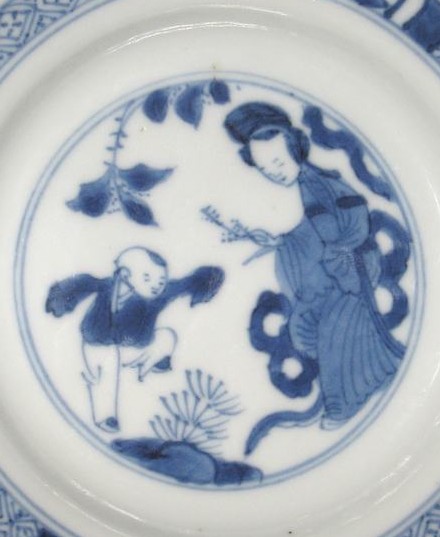
"Long Eliza" holding an osmanthus sprig
Image courtesy of: A Jacobs Coll. 2023
Long Eliza is a corruption of the Dutch "lange lijzen". Long Eliza is an old common name of a Chinese export porcelain decoration featuring one or two elongated women.
These long women often occur in Kangxi period blue and white decorations. The actual decoration could be one of many stories which, could be decided by the attributes.
In the case there is one tall women with a small boyish looking figure carrying a flower basket. Then elongated woman could be He Xiangu, one of the Eight Daoist Immortals and the shorter and boyish looking figure could be Lan Caihe, also one of the Eight Daoist Immortals.
If the tall woman is holding a flowering sprig in her hand: a beautiful woman holding a Osmanthus branch under a tree with a dancing child by her side is called "折桂婴戏". Zhe gui ying xi was from an ancient story of the Jin Dynasty. It implies the good meaning that after the child grows up, he will be able to pass the imperial court contest and becomes an official member. A Word by word translation is as following: zhe - pluck, gui - Osmanthus, ying - child, xi - play. This motif was very popular during the Kangxi period.
This "Zhe gui ying xi" is a traditional Chinese decorative motif that features a beautiful woman holding an Osmanthus branch under a tree with a dancing child by her side. The story of "Zhe gui ying xi" dates back to the Western Jin Dynasty (265-316 AD).
According to the legend, a man named Zhang Hua was a talented and ambitious young man who dreamed of passing the imperial court contest and becoming an official member. One day, he came across a beautiful woman named Xia Ying who was holding an Osmanthus branch under a tree with a dancing child by her side. Xia Ying was actually a fairy in disguise, and she told Zhang Hua that if he could pass the imperial court contest, she would marry him.
Zhang Hua was overjoyed by this promise and studied tirelessly for the imperial court contest. He eventually passed the exam and became an official member, and Xia Ying kept her promise and married him. The Osmanthus branch and the dancing child in the decoration symbolize the good fortune that comes with passing the imperial court contest and becoming an official member.
Today, the "Zhe gui ying xi" motif is often used in Chinese art and decorations as a symbol of academic and professional success. It is also sometimes used as a decorative motif for traditional Chinese weddings, where it represents the wish for the couple to have a successful and prosperous future together.
The legend of Zhang Hua and Xia Ying has been passed down through various forms of literature and art over the centuries. One of the earliest written sources of the story is the "Shishuo Xinyu" (世说新语), a collection of anecdotes and stories from the Sixteen Kingdoms to the Northern and Southern dynasties period, compiled by Liu Yiqing in the 5th century.
Another written source of the legend is the "Lienü Zhuan" (列女传), a collection of biographies of exemplary women from ancient China, written by Liu Xiang in the Western Han Dynasty. The story of Xia Ying is included as one of the biographies in the book.
As for the "折桂婴戏" motif, which is derived from this story, it has been depicted in various forms of art, including poetry, painting, and drama. You can find many examples of these works in museums and art galleries around the world, as well as in books and online resources about Chinese art and culture.
See also: Osmanthus fragrans - flower
A